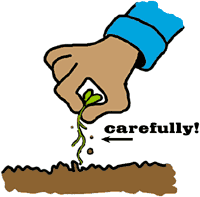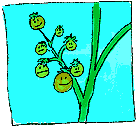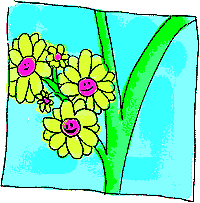Thinning
After planting your garden, check it regularly to ensure the soil stays moist. Don't forget to keep notes in your Garden Journal about when each type of plant developed its true leaves. If you planted small seeds in mini rows, you'll find it easier to tell the difference between desired plants and weeds because the plants you want should sprout around the same time and look similar. Keep your garden well mulched and free of weeds.
- Once the seedlings emerge from the soil and start to crowd each other, they will benefit from thinning or disbudding some of the plants.
- If you are growing plants for showing, then thinning out the smaller, weaker plants will leave you with bigger, showier plants.
- This will give the remaining plants more room to grow, allowing them to take nutrients from a larger area to produce bigger flowers, vegetables, or fruit.

- If you have an excess amount of the plant you are thinning, simply grab the surplus ones by the true leaves and pull them out of the ground, roots and all.
- If you want to transplant the extras to other places in your garden, you have to treat them with more care.
- Using your garden fork, gently loosen the soil around the plants you wish to move, leaving enough soil around the roots to form a ball.
- Try not to cut too many roots and root hairs, or the plant will not be able to re-establish itself.
- They can be transplanted to a new location, put into a container garden, or composted if you already have enough.
- Choose where you want to put your seedlings and dig holes wide and deep enough for the root ball, loosening the soil around the edges of the hole.
- Gently place the plant upright in the hole and fill all the empty space around the root ball with loose soil.
- Fill in the hole up to the top of the root ball and lightly pat it down. Do not pack it down too tightly or the roots will not receive any air at all.
- Mulch and water your transplanted seedlings well and watch them carefully for the first few days for signs of wilting.
- If your new plants wilt, there could be a large pocket of air between the root ball and the soil.
- Gently uncover the root ball, lift it up, and add more loose soil to the bottom of the hole.
- Replace the plant and repeat steps 4 to 6, not forgetting to water it well.


Disbudding means removing some of the new buds on the plant by pinching them off before they bloom. Flowers or vegetables that will be single and large should be disbudded early in their growing season by removing the smallest buds before they become fully formed.
caring
showing
|




